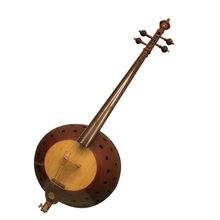Origin of Bass Ajay
117 views · Organized by 辞惘 on 2022-02-16
In the 1960s, the musicians of the Xinjiang Uygur Autonomous Region Song and Dance Troupe cooperated with the Uyghur musical instrument makers of the Urumqi Yidi Boke Musical Instrument Factory to design and develop the bass Aijie.

The headstock and stem are made of a piece of colored wood, 68 cm long. The headstock is cylindrical, the top is spherical, the bottom is opened with a string groove, four pegs are placed horizontally on both sides, and the shank is spherical. The piano bar is a semi-circular cylindrical body, flat at the front and round at the back, narrow at the top and wide at the bottom, with a mahogany fretboard glued on the front. The bottom base of the piano case is longer. Use cello strings and use a cello bow. Its playing posture and method are the same as the cello, and it is used as a bass-pulled stringed instrument in the Xinjiang Uygur Autonomous Region ethnic band.
Involving musical instruments
Bass Aijie (Pinyin dī yīn ài jié kè), also known as Harzak, is a Uyghur stringed instrument. In the Qing Dynasty, it was included in the Jiabu music. There are two kinds of Aijie musical instruments: one still retains the resonant strings, and the other has no resonant strings, and the latter one is commonly used.
 渝公网安备 50010702504639号
渝公网安备 50010702504639号